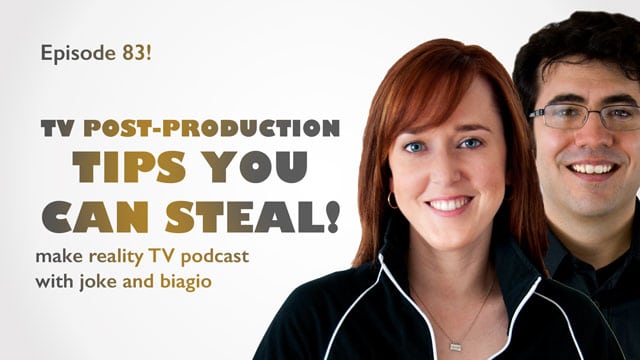Podcast: Play in new window | Download (Duration: 34:41 — 33.0MB)
Subscribe: RSS
In this episode, part 2 of Tools We Use to Make TV, we discuss our television post-production workflow. We’ve spent many years building a post workflow that can help us deliver any kind of TV or film project our company takes on. Today, we’re giving it all away to you. Take these tricks, tips, and insights and use them to help you build your own perfect television post-production workflow… while saving time and money.
Television Post-Production Starts in Pre-Production
Ever seen a project through from initial concept to final delivery? Then you already know that choices you make early on can have a severe effect on post. Questions that you have to ask yourself include:
- What camera should you use?
- Should you shoot 2k or 4k? (And is 4k worth it?)
- What editing software will best support those choices?
- How will 3D play a role in your production, both in graphics and computer generated imagery?
- Are you outputting for the web, kiosks, television, or motion picture theaters (or something more exotic?)
- Is the studio or TV network asking for special post deliverables?
It’s a lot to consider, and a lot can go wrong if you don’t plan right. That’s why waiting to think about post…until, well, post…is a huge mistake.
For instance, don’t shoot 6K raw on a RED WEAPON when you know you’ll be editing it on your 2009 laptop and streaming it on the web. Your computer will explode and almost no one will see the difference 6K gives you on YouTube.
Building A Post Workflow for Multiple Productions
Things get more complex when you’re building a company around your post workflow. For instance, at our TV and Film production company, Joke Productions, we produce a wide variety of TV and film projects. It wouldn’t be suitable to have a solution for only documentary series, since we also do competition elimination shows, true crime, reenactments, and live-to-tape studio shows.
Because of that, shaping our television post-production in “the right way” was a long, complicated journey. Ultimately, it came down to building a workflow based on two things:
- reliability
- flexibility
In that order.
Reliability of your post workflow is the most important thing. You can’t have your system go down when you’re up against a delivery date, or have twenty editors trying to meet those dates.
Flexibility, a close second, ensures that you can adapt to any production you’re lucky enough to get off the ground.
Choosing Post-Production Tools Wisely
Another stumbling block in building your post workflow is deciding which of the many existing post tools are right for you. Will you use a prepackaged suite of tools, or save money by piecemealing a unique solution together? For instance, will you just get Adobe CC and call it a day? Or will you use free and open-source alternatives to get yourself up and running? If you do use less-known tools, will you be able to find and hire people who know them if you get busy?
In addition, you need to decide if you’ll handle all of your post-production needs in-house, or if you’ll build part of a pipeline and send some work to third-party vendors. (For example, many production companies will outsource sound-mixing or color correction.)
Finally, you have to be honest about your budget and your potential income. It just doesn’t make sense to spend $100,000 on post equipment when you’re just starting out. Especially when so many free and inexpensive tools can still allow your to achieve pro-level work.
As a result of these considerations — things get mind-boggling pretty quick! Even for those of us who’ve been in the industry awhile. After all, nothing changes faster than technology.
Our Workflow is Less Important Than Our Thought-Process…And Yours!
Today’s podcast episode hopes to give you a big picture overview of tools we’re using right now. In addition, and even more important, we try to give you some idea of why we chose those tools and when and how we use them.
As with many things in life and business, the “why” is really more important than the “how” and television post-production is no exception.
If you listen to this podcast regularly, you already know from this episode on editing TV that we use the Adobe Suite extensively, but that’s one considertation in our post workflow. We have a multitude of tools we rely on to stay flexible, and use different tools on presentations, pilots, and series. Want to know why? Press the giant “PLAY” button at the top of the page.
Just some of what we cover today:
- Our word of the day – and why it makes your projects better
- The Mac / PC debate. Where we stand, and why that might surprise you
- Why choosing software when you’re solo and indie is different than choosing it for your company
- Software we use for editing, color grading, sound mixing, and visual effects…
- …Why we chose that software…
- …And why that software might or might not work for you
- Great free alternatives to pro post-production software you can download right now
- An incredible way to get free training to learn new software
- And…Biagio makes strange sound effects with his mouth.
For all this and more (and did we mention Biagio’s weird sound effects?) hit that giant PLAY button at the top of this page!
Transcript Coming Soon!
Helpful and Related Links
- Follow us on Twitter! @jokeandbiagio
- Part 1 of this two-part series: Tools We Use to Make TV
- All about Stu Maschwitz, who made the Magic Bullet plugin and has other great stuff to help you make great film & TV
- Live in Los Angeles? Get a Los Angeles Public Library Card and then get your free Lynda.com account. You can then learn how to use any software out there: Read about it here, and pick up other freebies, too!
- Download free compositing and color correction software
- A great free software program for post-production sound work – Audacity
- How to Pitch a Reality Show – everything you ever wanted to know in this free 10,000 word guide.
Let’s Make Some TV Together
Trying to break into unscripted TV, reality television, or documentary series? Want to pitch to our company? Here’s how:

